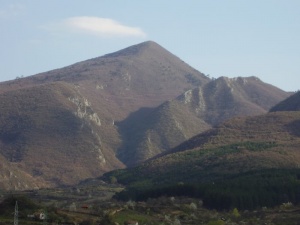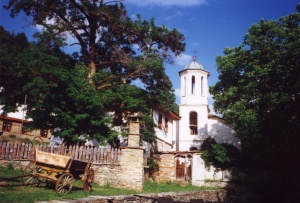Information about the town of Gotse Delchev
Gotse Delchev PropertiesThe town of Gotse Delchev has a population of 20 546 inhabitants and is 540 m above sea level. It is situated in the valley of the Mesta River, along the banks of its right tributary - the Nevrokop River. It is 22 km north of the Greek border, 51 km south of Bansko, 112 km away from Blagoevgrad and 212 km away from Sofia.
It bears the name of legendary Gotse Delchev, ideologist and leader of the Bulgarians from Macedonia in their struggle against the Ottoman domination (till 1959 the town’s name had been Nevrokop). To the west above the town is the Mid Pirin Mountain Massif, and to the east opposite to it is the south-western sub-part of the Western Rhodopes called Dubrash Mountain.
The first information about this settlement dates back to 9th-10th centuries and in 15th century the name of Nevrokoub was mentioned. In 1625 it was registered as a town. During the Ottoman rule the town developed as a crafts centre. It was famous for the production of small and large cow and sheep bells - the renowned chanove for the herds in Pirin and the Rhodopes (the tradition is been preserved only here). The crafts of skin processing and saddlery also developed. Annual trade fairs were held in the town during the second half of 14th century. In the Revival Period the inhabitants of the town showed acute national consciousness. They erected churches, a monastery school, a secular school, separate schools for young boys and young girls respectively, a communal cultural centre. As stipulated in the Berlin Treaty the town remained in the territory of Turkey and was liberated in the Balkan War (October 1912). The town gave shelter to many refugees from the Serr and Drama areas.
The Town Museum of History is located in a house dating back to 1879 (Hristo Botev Str., the Central Square). The Revival Architectural Complex of Rifat Bei (in the old central part of the town). The historical Holy Virgin Church dating back to 1833; the St. Archangel Michail Church (11, Ekzarh Antim Str.). The private ethnographic collection of Zafir Kunchev. The 500 year-old plane tree is a natural sight of the town. The tree is 24 metre high with perimetre of the trunk of 7.6 metres.
The biggest of all is the Nevrokop Hotel in the centre of the town. Smaller but cosier are Malamovata Kashta Hotel (Malamov’s House) (25, Hristo Botev Str.) and Mesta Hotel. The Rorest Rest House welcomes guests, too. There is a Tourist Hostel near the bus station (26 Soloun Str.).
Tourist Information: Tourist Information Centre, 2900 Gotse Delchev, 2, Tsaritsa Yoanna Str. Council on Tourism (2900 Gotsa Delchev, 2, Tsaritsa Yoanna Str.). The Momini Dvori Tourist Association (in the tourist hostel).
The connection of Gotse Delchev to the rest of the country is only by bus transport. There are regular bus lines to Sofia, Plovdiv, Blagoevgrad, Razlog, Bansko, Dobri-nishte and all the villages in the district. The town has got three bus stations – Central Bus Station, Bus Station-Zapad and a private bus station.

In honour to his victory over the Dacian tribe Emperor Trayan (98-117) built the ancient Roman town called Nikopolis ad Nestum whose remains are to be found 7 km east of Gotse Delchev, in the Zagrade Quarter of the village of Gurmen, on the left bank of the Mesta River. The fortification walls have the shape of an irregular quadrangle. Its imposing remains are an evidence of its past grandeur. It used to be an important crossing point of the roads connecting the ancient towns by the Aegean Sea with the valley of the Hebros River (Maritsa River).
Twenty-five kilometres north-east of the town, in the Dubrash Massif of the Rhodopes, high on the left bank of the Kanina River is the village of Kovachevitsa - a unique architecture and historical reserve. Time seems to have stopped forever. The Rhodope houses resembling fortresses are magnificent. The nature is magical, the atmosphere of the narrow cobble stone streets between high stone walls, the hospitality of local people are inforgettable. A number of famous people have bought houses here and spend a great part of their time in this fairy place. Kovechevitsa is a paradise not only for artists but also for anyone of poetical soul. The village is the native place of the poet Lyudmil Stoyanov. There is a regular bus line to Gotse Delchev. Some of the old houses have been turned into hotels offering specialities of the original Rhodope cuisine - these are the the Bayatev’s House, the Daskalov’s, the Zhechev’s House, the Kapsuzov’s House, the Milchev’s and the Spasov’s House.
Sixteen kilometres west of the Popovi Livadi Saddle between Middle and South Pirin is the holiday resort of the same name (about 1400 metres above sea level). There is no regular transport. It takes 4.30-5 hours to walk there along a marked track. The vast green fields surrounded by thick and impenetrable spruce forests create wonderful conditions for escape from the tension of the big town. There are accommodation opportunities as well – the Popovi Livadi Chalet offering 70 beds in different rooms. The Papazov Villa, the Orbel Ltd. Rest House, the Pirinplast Ltd. Rest House, the Orelyak Rest House, the Bulgartabac Hotel.
One could go on hiking trails to Mt. Orelyak (2099 m above sea level, the highest peak of Middle Pirin, 2 hours), the Malina Chalet (5-6 hours), the Pirin Chalet (7 hours), and along an unmarked track to the highest peak of South Pirin called Mt. Sveshtnik (1975 m above sea level, 2 hours).
The following sights are of great interest as well: the ancient and medieval fortresses in the Gradishteto Area, the waterfall at the Toufcha River, the Draganov Rocks, the Momina Koula (Maiden’s Tower) Fortress, the Soudin Grad Fortress dating back to late ancient times and the Middle Ages, the Holy Virgin Monastery, the St. Martyr Georgi Monastery, the meanders of the Mutenitsa River, the Mousomish mineral springs in the area of Toplika, the Pavlov’s Saddle, the Manouilova Doupka Cave (Manouilov’s Hole), the precipice cave called Propaduka, the Steneto rock formations in the gorge of Kochanska River, the rock formation called the Koziyat Kamuk (Goat’s Stone), the rock formation called Koupena in the area of Trebichki Dol, the Pirostiyata rock formation, the Black Rock.
Gotse Delchev Properties

